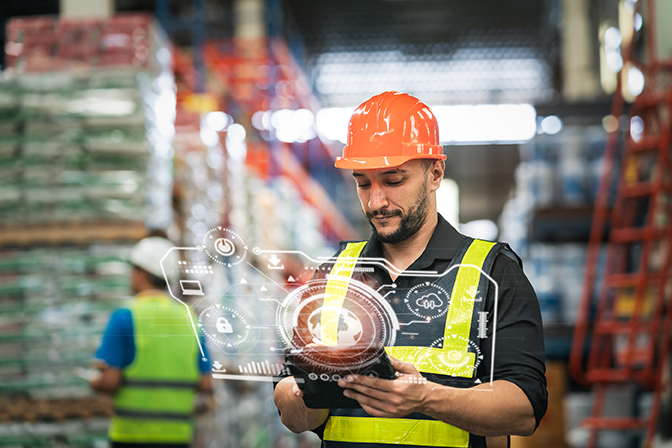Inside Johnson & Johnson’s Supply Chain Operations
- Industry 4.0 / IIoT
- Supply Chain

Johnson & Johnson is a long-established leader in the healthcare sector. Founded in 1886 with just 14 employees, it now provides global solutions for pharmaceuticals, medical devices, and consumer goods.
Today, Johnson & Johnson operates over 250 companies that employ more than 152,000 people worldwide, generating an annual revenue in excess of $21.3B. And it owes its monumental success in part to its supply chain.
Because supply chain management (SCM) is so crucial to the quality of the products it produces, Johnson & Johnson has deliberately made SCM a core focus of their business.
The Evolution of Supply Chain Management at Johnson & Johnson
In years past, supply chain management was simpler and more straightforward. Companies favored geographically proximate suppliers for their needs.
More recently, the transition to a truly global marketplace has transformed how companies, including Johnson & Johnson, approach their supply chains. This shift necessitated the adoption of digital technologies to manage the complex logistics of sourcing materials and delivering products internationally.
From barcode scanning and mobile solutions to smart control towers, looking to technology has helped Johnson & Johnson become—and remain—a titan in its market space. As a result, Johnson & Johnson’s supply chain evolution stands as a testament to its foresight and adaptability, emphasizing not just efficiency but also resilience.
The digital transformation taking place within Johnson & Johnson’s supply chain is not because of a drive to keep up with technological trends. Instead, the strategic utilization of technology enabled the company to pre-empt and respond to global challenges of all kinds.
As we’ve seen, the COVID-19 pandemic underscored the importance of such an approach. Johnson & Johnson’s success during the pandemic exemplifies how foresight and investment in supply chain infrastructure can pay dividends in times of crisis.

What Companies Can Learn from the Coca-Cola Supply Chain
READ NOW »Supply Chain Challenges During the COVID-19 Pandemic
Today’s global marketplace is already complex. Interlocking logistics and supply chain operations must operate continuously and smoothly for goods to flow. For large operations like Johnson & Johnson, delivering products and raw materials across multiple stakeholders and countries is no less than a monumental challenge.
When the COVID-19 pandemic struck, it added a new and unpredictable layer of complexity, testing the resilience and adaptability of supply chains worldwide.
Johnson & Johnson’s supply chain proved to be one of the few that demonstrated the nimbleness to adapt and thrive amid uncertainty.
During that time, the company faced an unprecedented demand for healthcare products, from over-the-counter medications to medical devices. Johnson & Johnson’s supply chain was put to the test.
By leveraging advanced planning and digital tools, the company was not only able to meet the surge in demand but also to ensure the continuous supply of essential healthcare products to those in need.
Leveraging High-Tech Tools During the Pandemic
During the COVID-19 pandemic, Johnson & Johnson faced unprecedented challenges in its supply chain. Surges in demand for essential products like Tylenol, which saw demand double early in the pandemic, proved salient.
The company responded by maximizing product availability, running its plants 24/7, and making strategic trade-offs, such as reducing the production of more complex formulations to focus on producing high volumes of the most needed medicines.
This agility was part of a broader strategy to manage or circumvent disruptions, ensuring that hospitals, pharmacies, and people worldwide continued to receive much-needed medications, medical devices, and other healthcare products.
To address pandemic challenges, Johnson & Johnson leveraged cutting-edge supply chain technologies and innovative approaches. Some of these technologies included smart glasses with remote access capabilities and track-and-trace sensors powered by GPS to maintain smooth operations across its manufacturing and shipping facilities globally.
These technologies allowed for real-time monitoring and management of the supply chain, ensuring end-to-end visibility of shipments and enabling the company to respond to the dynamic market patterns caused by the pandemic.
Through these efforts, Johnson & Johnson was able to continue serving patients, consumers, healthcare providers, and customers worldwide, despite the challenges posed by COVID-19.
“A lot can happen between the time a package leaves a manufacturing plant and its arrival at the final destination. Enter track-and-trace sensors that travel with a shipment, allowing for ‘end-to-end visibility.”
Kevin Whitehead | Head of Digital Strategy, Supply Chain, Janssen Pharmaceutical Companies of Johnson & Johnson
Strategic Planning and Customer Experience Enhancement
At the heart of Johnson & Johnson’s supply chain strength lies a deep commitment to strategic planning and enhancing the customer experience. Recognizing the changing expectations of both B2B and B2C clients, Johnson & Johnson has embraced digital technology to introduce new efficiencies and a level of personalization previously unseen in the healthcare sector.
Enhancing Customer Service
Pivotal to this transformation was the Johnson & Johnson advanced planning team. Tasked with developing an end-to-end infrastructure, they set out to streamline operations and improve customer satisfaction.
Personalization and automation were their key strategies. Today’s customers demand instant solutions and prefer self-service options over traditional customer service calls.
Johnson & Johnson responded by implementing chatbots and instant messaging services, allowing for quicker and more efficient customer interactions. For more complex queries requiring human intervention, these digital tools help free up staff, ensuring that customers receive the support they need without unnecessary delays.
This shift towards digital customer service solutions represents a broader trend in supply chain management, where technology is used to enhance operational efficiency while creating a more customer-centric experience.
Any supply chain can benefit from leveraging these same basic principles.

Getting Started with Warehouse Automation
DOWNLOAD NOW »Supply Chain Automation
As we’ve seen, during the pandemic, Johnson & Johnson’s strategic supply chain planning relied on automation technology to stay afloat. Technology combined with thorough preparedness bolstered business continuity.
For instance, the foresight to integrate and test track-and-trace sensors enabled the company to create end-to-end supply chain visibility. When the pandemic hit, operations knew exactly where in the supply chain all its materials were at any given point.
In addition, the company went to great efforts to prevent unnecessary stockpiling. The company also reassured customers and partners about product availability to mitigate instability in the market. This fostered a sense of reliability and trust among consumers as well.

Guide: Unpacking Supply Chain Traceability
DOWNLOAD GUIDE »Data and Robotics: Pioneering Supply Chain Innovation
Part of Johnson & Johnson’s supply chain innovation revolves around data analytics and robotics. Used to drive efficiency and reliability in manufacturing and logistics, these technologies have proven their effectiveness when strategically applied.
In one case, the company introduced YuMi, a collaborative dual-arm robot—and an example of the company’s willingness to experiment with next-generation manufacturing tools. YuMi’s precision and ability to work alongside humans have revolutionized routine tasks on the factory floor, significantly boosting productivity and ensuring that products reach consumers faster.
Beyond robotics, Johnson & Johnson’s strategic use of data has led to a more predictive and responsive supply chain. By deploying data crawlers to gather and analyze vast amounts of information, the company is able to create a sophisticated analytics layer.
This data-driven approach allows for accurate forecasting, improved decision-making, and the identification of inefficiencies within the supply chain at a granular level.
In harnessing data to inform every aspect of its operations, Johnson & Johnson not only enhances product delivery but also pioneers improvements in healthcare delivery itself.
Collaborations and Future Technologies
To further optimize its supply chain, Johnson & Johnson’s strategy has been to focus on collaboration and investment in future technologies. The ultimate aim is to address operational efficiency and patient care at the same time.
A notable example of such collaboration is their partnership with public hospitals in Italy to implement the ‘Resolution’ system. This system significantly reduces the time clinical staff spend on logistical tasks. In this way, the initiative streamlines hospital operations while allowing healthcare professionals to focus more on patient care.
Looking ahead, Johnson & Johnson is exploring innovative technologies like digitally augmented pill bottles and even more advanced traceability software. These initiatives are aimed at improving patient outcomes by ensuring medication adherence and verifying the authenticity of drugs, respectively.
With initiatives like these, Johnson & Johnson continues to set new standards for how supply chains can contribute to healthcare advancements.
Lessons Learned from Johnson & Johnson’s Supply Chain Success
Johnson & Johnson’s innovative approach to supply chain management exemplifies how foresight, adaptation, and strategic use of technology can help companies navigate global challenges—and thrive. Careful testing for potential challenges combined with the strategic use of supply chain technology solutions have contributed to astounding success. Today, Johnson & Johnson is a globally recognized brand in healthcare and life sciences. The company remains highly profitable and highly regarded. And it’s all thanks to their emphasis on innovation and continuous improvement.




